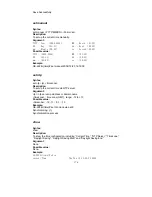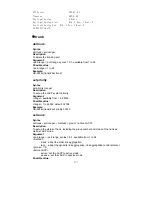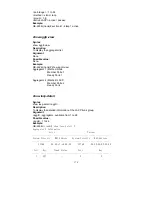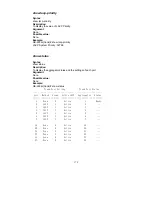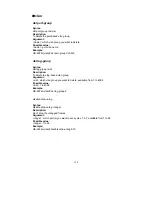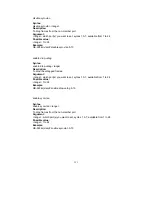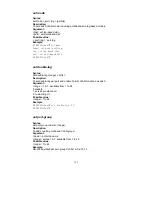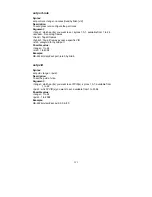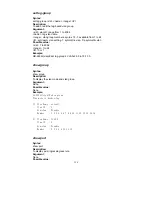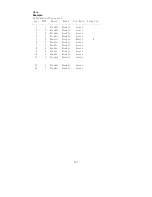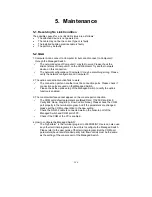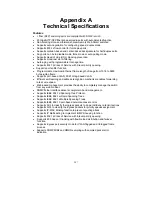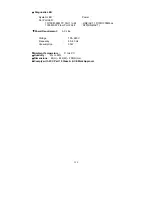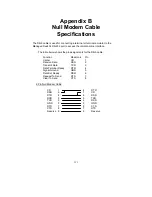
290
Management Software Specifications
System Configuration
Auto-negotiation support on 10/100/1000 Base-
TX ports, Web browser or console interface can
set transmission speed (10/100/1000Mbps) and
operation mode (Full/Half duplex) on each port,
enable/disable any port, set VLAN group, set
Trunk Connection.
Management Agent
SNMP support; MIB II, Bridge MIB, RMON MIB
Spanning Tree Algorithm
IEEE 802.1D
VLAN Function
Port-Base / 802.1Q-Tagged, allowed up to 256
active VLANs in one switch.
Trunk Function
Ports trunk connections allowed
IGMP
IP Multicast Filtering by passively snooping
on the IGMP Query.
Bandwidth Control
Supports by-port Egress/Ingress rate control
Quality of Service (QoS)
Referred as Class of Service (CoS) by the
IEEE 802.1P standard ,Classification of packet
priority can be based on either a VLAN tag on
packet or a user-defined
Per port QoS.
Two queues per port
IP TOS Classification
TCP/UDP Port Classification
IP DiffServe Classification
Port Security
Limit number of MAC addresses learned per
port static MAC addresses stay in the filtering table.
Internetworking Protocol
Bridging : 802.1D Spanning Tree
IP Multicast : IGMP Snooping
IP Multicast Packet Filtering
Maximum of 256 active VLANs
and IP multicast sessions
Network Management
One RS-232 port as local control console
Telnet remote control console
SNMP agent : MIB-2 (RFC 1213)
Bridge MIB (RFC 1493)
RMON MIB (RFC 1757)-statistics
Ethernet-like MIB (RFC 1643)
Web browser support based on HTTP Server
and CGI parser TFTP software-upgrade capability.
Note: Any specification is subject to change without notice.
Summary of Contents for GS-2224L
Page 1: ......
Page 2: ......
Page 34: ...24 Fig 2 15 Office Network Connection Fig 2 14 Peer to peer Network Connection ...
Page 78: ...68 Fig 3 28 ...
Page 83: ...73 Fig 3 31 ...
Page 91: ...81 Fig 3 39 Fig 3 40 Fig 3 41 ...
Page 113: ...103 Fig 3 67 Ingress Port Fig 3 68 ...
Page 115: ...105 Fig 3 71 Fig 3 72 Fig 3 73 ARP Fig 3 74 ARP ...
Page 116: ...106 Fig 3 75 ARP Fig 3 76 ARP Fig 3 77 ARP Fig 3 78 ARP ...
Page 117: ...107 Fig 3 79 ARP Fig 3 80 ARP Fig 3 81 ARP Fig 3 82 ARP ...
Page 118: ...108 Fig 3 83 ARP Fig 3 84 ARP Fig 3 85 ARP Fig 3 86 ARP Fig 3 87 ARP ...
Page 119: ...109 Fig 3 88 IPv4 Fig 3 89 IPv4 Fig 3 90 IPv4 ...
Page 120: ...110 Fig 3 91 IPv4 Fig 3 92 IPv4 Fig 3 93 IPv4 Fig 3 94 IPv4 Fig 3 95 IPv4 ...
Page 121: ...111 Fig 3 96 IPv4 Fig 3 97 IPv4 Fig 3 98 IPv4 Fig 3 99 IPv4 Fig 3 100 IPv4 ...
Page 122: ...112 Fig 3 101 IPv4 Fig 3 102 IPv4 Fig 3 103 IPv4 Fig 3 104 IPv4 ...
Page 123: ...113 Fig 3 105 IPv4 Fig 3 106 IPv4 Fig 3 107 IPv4 ...
Page 124: ...114 Fig 3 108 IPv4 Fig 3 109 IPv4 Fig 3 110 IPv4 Fig 3 111 IPv4 ...
Page 125: ...115 Fig 3 112 IPv4 Fig 3 113 IPv4 Fig 3 114 IPv4 ...
Page 126: ...116 Fig 3 115 IPv4 Fig 3 116 IPv4 Fig 3 117 IPv4 ...
Page 127: ...117 Fig 3 118 Action Fig 3 119 Rate Limiter ...
Page 128: ...118 Fig 3 120 Port Copy Fig 3 121 DMAC Filter ...
Page 129: ...119 Fig 3 122 VLAN ID Filter Fig 3 123 VLAN ID Filter Fig 3 124 Tag Priority ...
Page 141: ...131 Fig 3 126 Set up Policy Rules Fig 3 127 Set up Policy Rules Fig 3 128 Set up Policy Rules ...
Page 143: ...133 Fig 3 132 Set up Port Policies Fig 3 133 Set up Port Policies Finish ...
Page 159: ...149 Fig 3 145 ...
Page 204: ...194 Fig 4 1 Fig 4 2 ...

